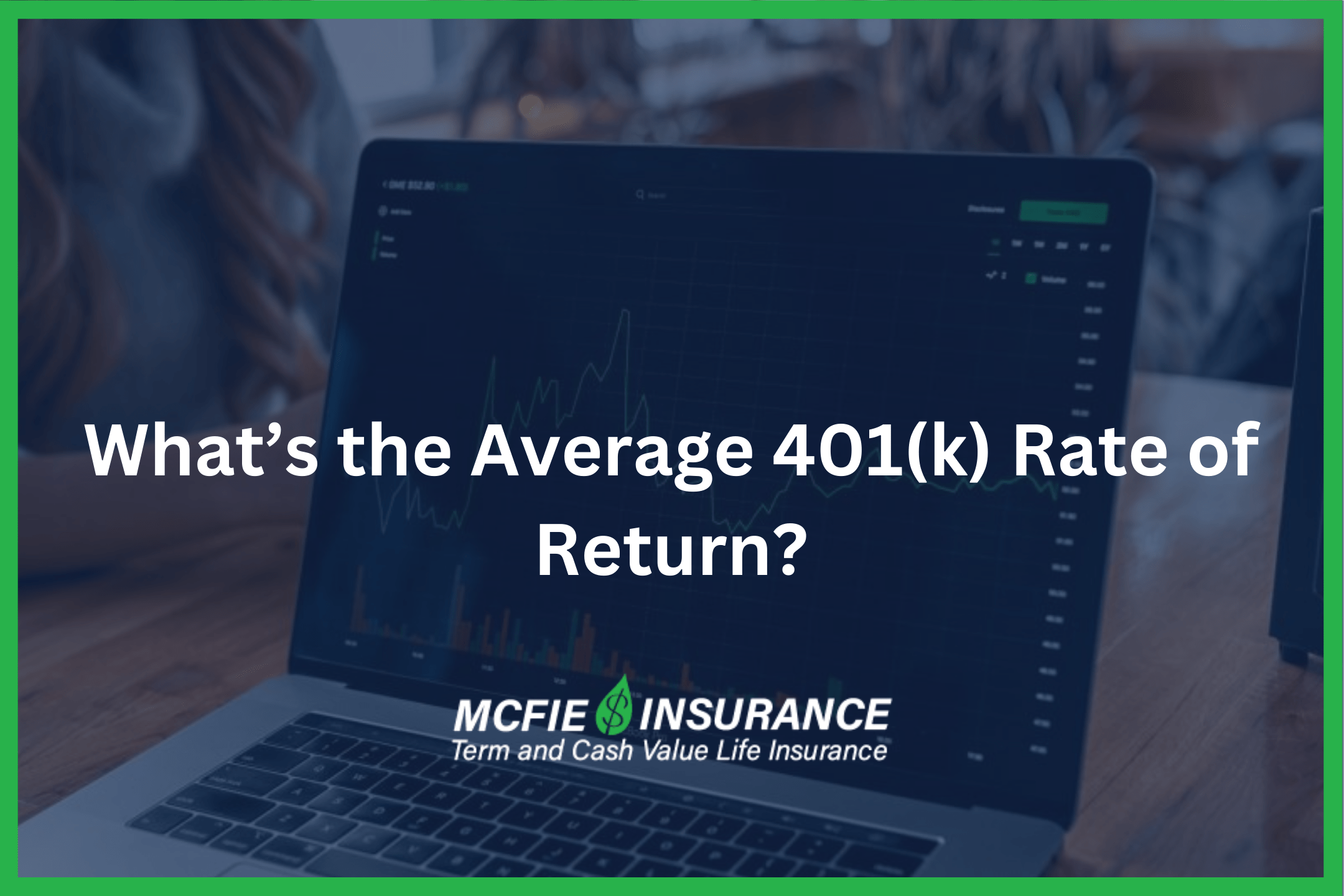702-660-7000
702-660-7000

Most advisors and financial planners still advise their clients to participate in a 401(k) plan when available. Typically, advisors project an average rate of return for those funds invested in a 401(k) plan over the next 20 to 30 years to be somewhere between 5 to 8%. Unfortunately, for numerous reasons, this doesn’t mean a 401(k) will actually realize a 5-8% return. To understand why, let’s explore what a 401(k) is, how to calculate your average 401(k) return, as well as some other options.
The IRS defines a 401(k) as “a feature of a qualified profit-sharing plan that allows employees to contribute a portion of their wages to individual accounts.”
In other words, employees have the option of directing a portion of their pay to a company-sponsored investment account. Because participants contribute pre-tax dollars from their wages to their 401(k) accounts, their annual taxable income is reduced.
Contributions and growth in a 401(k) account are tax-deferred until the funds are withdrawn.
When considering a 401(k) plan, it’s crucial to understand certain aspects that might impact your investment. Here are key points to consider:
1) Fees: 401(k) plans typically charge around 1% fee on managed assets. For example, with $100,000 in your account, you could pay $1,000 annually. These fees can significantly accumulate over time, reducing overall returns. It’s vital to check with your plan provider or employer’s HR department for specific fee details, as some investment accounts may not have management fees.
2) Vesting: Your personal contributions to the 401(k) are fully yours. However, employer contributions might follow a vesting schedule, determining when you gain full ownership of these funds.
3) Early Withdrawal Penalties: Withdrawing funds from your 401(k) before age 59 ½ usually incurs a 10% penalty, in addition to standard taxes. This is because the government encourages the growth of these savings. At age 73, you’re mandated to start taking minimum distributions from these accounts.
4) Investment Options: 401(k) plans offer at least three basic investment choices: stocks, bonds, and cash or stable value options. While many plans offer a broader range of mostly mutual funds, those seeking to invest beyond these basic asset classes might find the options limiting.
It’s important to be well-informed about these aspects to make the most beneficial decisions regarding your 401(k) investments.
An average 401(k) rate of return is the sum of all returns earned, divided by the number of all the periods. Thus, the average 401(k) rate of return is the same as the annual rate of return only in year one (see chart). After year one, the 401(k) average rate of return can be quite different than might be expected.
| Year | Annual Return | Average Return |
| 1 | -12% | -12% |
| 2 | 15% | 1.5% |
| 3 | -14% | -3.67% |
| 4 | 32% | 5.25% |
| 5 | 10% | 6.2% |
| 6 | 4% | 5.833% |
In a 401(k) with contributions of $5,000 per year, and the sequence of returns you see on the left, the ending 401(k) balance would be $39,002.35 rather than $36,756.04 which would be an annual 5.833% return on the same $5,000 annual contribution over 6 years.
| Year | Year End Balance |
| 1 | $4,400.00 |
| 2 | $10,810.00 |
| 3 | $13,596.60 |
| 4 | $24,547.51 |
| 5 | $32,502.26 |
| 6 | $39,002.35 |
Furthermore, if the annual 401(k) rates of return had occurred in reverse order, the average rate of return would remain 5.833%, but the average rate of return at the end of each year along the way would be quite different. This would alter yearly growth as well as the ending balance of the 401(k) which you see is now $6,556.85 less than before.
| Year | Annual Return | Average Return |
| 1 | 4% | 4% |
| 2 | 10% | 7% |
| 3 | 32% | 15.33% |
| 4 | -14% | 8% |
| 5 | 15% | 9.4% |
| 6 | -12% | 5.833% |
| Year | Year End Balance |
| 1 | $5,200.00 |
| 2 | $11,220.00 |
| 3 | $21,410.40 |
| 4 | $22,719.94 |
| 5 | $31,869.89 |
| 6 | $32,445.50 |
If total contributions remain the same, but differing annual contribution amounts are contributed each year, the future 401(k) balances will be different as well, even though the same average rate of return is earned.
Determining the average rate of return for a 401(k) is not straightforward due to various influencing factors. Here’s a breakdown of key aspects to consider:
1) Factors Influencing Returns: The performance of a 401(k) depends on the available investment options within your plan and the composition of your individual portfolio. Market fluctuations also play a significant role, affecting returns from year to year.
2) Expected Return Range: Despite uncertainties, a common expectation is an annual return ranging between 5% and 8%. However, this range is not a guarantee; returns can sometimes surge into double digits or even dip into negative territory.
3) The Limitation of Averages as Indicators: Using average returns as a benchmark can be misleading. For example, averages might not accurately represent the distribution of returns in a data set. An analogy can be drawn to a scenario where a billionaire’s presence in a diner skews the average wealth of the patrons, which doesn’t accurately reflect each individual’s financial status.
4) Understanding Averages and Medians: It’s beneficial to educate yourself about the concepts of averages and medians. Assessing whether targeting an average return is practical or realistic requires understanding these statistical measures and their implications in your specific context.
While there are general expectations regarding 401(k) returns, individual experiences may vary significantly due to several factors, including market conditions and investment choices.
For these reasons, Ted Benna, the father of the 401(k) plan, states “I learned a long time ago…that average returns are pretty meaningless, that a higher average doesn’t mean you will have more money.”
For this reason, most 401(k) accounts never earn what they were projected to earn. According to Vanguard, those aged 65 and older have an average of only $255,151.00 in their 401(k). The median 401(k) account balance is a mere $82,297.00 for this same age group.
And according to Financial Advisor Magazine (fa-mag.com), a 401(k) tax deferral in 1980 was equivalent to an additional investment return of 9.2%, which was an extraordinary incentive to contribute to a 401(k), even without the employers match. But today the tax deferral benefits for contributing to a 401(k) plan is a mere 0.6%, which is less than the 1% and 2% of costs and fees which investors pay in a typical 401(k) plan.
Costs and fees are another reason why the 401(k) plan has been seriously questioned by authorities as to still be the best place to build and sustain retirement income. Here are several costs and fees which must be accounted for when looking to calculate your 401(k) return:
1) Administration fees which are paid via debit from the 401(k) account
2) Investment fees which are directly deducted from investment returns of a 401(k)
3) Service fees are typically charged to the employee’s 401(k) account
4) Settlor fees which normally are paid by the employer
A total of 1.5% of costs and fees in a 401(k) plan, which started with $25,000 and earned a 7% annual rate of return with annual contributions of $10,000 each year, destroys 40.70% of the potential growth after 40 years. Increasing those costs and fees to 2.5% will destroy over half of the potential growth (59.36%), making costs and fees destructive to both building and sustaining wealth in a 401(k) plan.
Today, “1 out of 4 seniors would be living in poverty without their Social Security income. Social Security provides more than 50% of the income which American seniors receive. Yet the average Social Security monthly income is only $1,413”, meaning $16,956 of income annually is all that is keeping most seniors from living below the poverty level.
It is recognized by the U.S. Bureau of Labor Statistics that most Americans need at least $46,000 per year in order to survive retirement without running out of money. And yet, over 40% of Americans admit they are doing nothing to prevent running out of money before they die. Others are saving money in the wrong places and assuming way more risk than they need to because they are being told that the 401(k) is still the best place to save for their retirement. Benna fully understands this enigma stating there are those “who are following the typical investment strategy that is promoted out there, taking much higher levels of risk than they should be, much higher, and the potential to get hammered without being able to recover is pretty scary.”
Then there are those who have aggressively funded their 401(k) and may still not have enough money to last through retirement. It is a known fact that Only 1.6% of 401(k) and IRA owners have become 401(k)/IRA millionaires. And even though these millionaires have done everything they have been told to do, their high 401(k) balances will become a tax liability for them due to the required minimum distribution (RMD) regulations. RMDs on large 401(k) balances trigger Social Security and income taxes which may be partially avoided with some simple financial pre-planning. And 401(k) money which is inherited, creates an entirely new set of tax liabilities for the beneficiaries since the Tax Cuts and Jobs Act of 2017 was enacted.

An easy read and a perfect introduction to whole life insurance and The Perpetual Wealth Code™ Available in eBook or Audiobook format.
Download here>
Finally, there is a liquidity issue with money invested in 401(k) plans. Generally speaking, if the owner is under 55 the only way to access money from a 401(k) is via a loan, a hardship withdrawal, or a rollover to an IRA. Once retired, and retirement can’t have occurred prior to age 55, then distributions can be taken from a 401(k) without the 10% IRS tax penalty. From 59½ to 72, money can be withdrawn from a 401(k) but only from a 401(k) plan NOT sponsored by a current employer. After age 72 RMDs are required and must be taken no later than April 1st of the year after one turns 72 unless the 401(k) plan offers an exception to this mandatory rule.
Such limitations and restrictions have been the demise of many good-sized 401(k) accounts when the market dives into the previous territory. This happened in 2000 through 2002 when annualized returns dropped -9.03%, -11.85%, and -21.97% respectively, and in 2008 when the market corrected a whopping -36.55% severely depleting many 401(k) plans. Market corrections leave fewer options for the 401(k) plan owner depending on the plan to fund retirement.
When it comes to managing a 401(k), there are several strategies available, each with its own approach and without guaranteed returns. Here’s an overview of some common methods:
1) 60/40 Asset Allocation: This strategy involves allocating 60% of the portfolio to equities (stocks) and 40% to bonds. The goal is to balance risk and return, offering consistent gains even during market volatility.
2) Target-Date Funds: These are mutual funds designed around your expected retirement year. A fund targeting 2050 may have a more aggressive mix, leaning more towards stocks for higher returns. Conversely, a 2025 fund focuses on safety, predominantly investing in bonds to protect those nearing retirement. However, market conditions can still affect returns.
3) Utilizing Financial Advisors: Many 401(k) plans offer the option of consulting with a financial advisor. If your plan doesn’t, or if you seek more comprehensive guidance, you can consider hiring a financial professional to align your investment with both short-term and long-term goals.
4) Diversifying with Multiple Retirement Accounts: You can combine the basic options of your workplace 401(k) with other retirement accounts for a more diverse approach. Options include a traditional IRA for continued tax advantages, a Roth IRA to reduce future tax liabilities, or an individual investment account for more personalized stock investments.
Each of these strategies has its unique considerations and potential benefits, and the choice depends on individual financial goals, risk tolerance, and retirement timeline. It’s important to understand the specifics of each approach, including the differences between a 401(k) and an IRA, before making a decision.
Contrast this with participating whole life insurance which guarantees a specific premium on your plan which will produce a specific and guaranteed cash value each and every year, and this specific value will be contractually guaranteed at the time of signing the life insurance contract. In addition, participating whole life insurance contracts guarantee surplus profits will be shared with policyholders in the form of tax-preferred dividends. These dividends, over time, can match or exceed historical returns which the 401(k) investor must wrestle with each and every year. In addition to this, the death benefit of a life insurance policy passes tax-free to the beneficiary(s) of the policy avoiding taxes associated with inherited 401(k)s. An owner of a participating whole life policy can also create a guaranteed lifetime income by rolling the cash values of the policy into a fixed guaranteed annuity which avoids the risks of the market associated with 401(k) plans.

Understanding the Infinite Banking Concept and How It Works In Our Modern Environment 31-page eBook from McFie Insurance Order here>
Participating in whole life insurance completely dodges the typical investment strategy of using high-risk investments which Ted Benna, the father of the 401(k) plan, has so prudently warned investors to avoid. And in retirement, participating in whole life insurance can be used to help avoid taxes on Social Security benefits which is a consequence some 401(k) account owners will have to face.
Note: Investing information provided on this page is for educational purposes only. McFie Insurance does not offer advisory or brokerage services and does not recommend or advise investors to buy or sell particular securities.
 Dr. Tomas P. McFie
Dr. Tomas P. McFie
Most Americans depend on Social Security for retirement income. Even when people think they’re saving money, taxes, fees, investment losses and market volatility take most of their money away. Tom McFie is the founder of McFie Insurance which helps people keep more of the money they make, so they can have financial peace of mind. His latest book, A Biblical Guide to Personal Finance, can be purchased here.